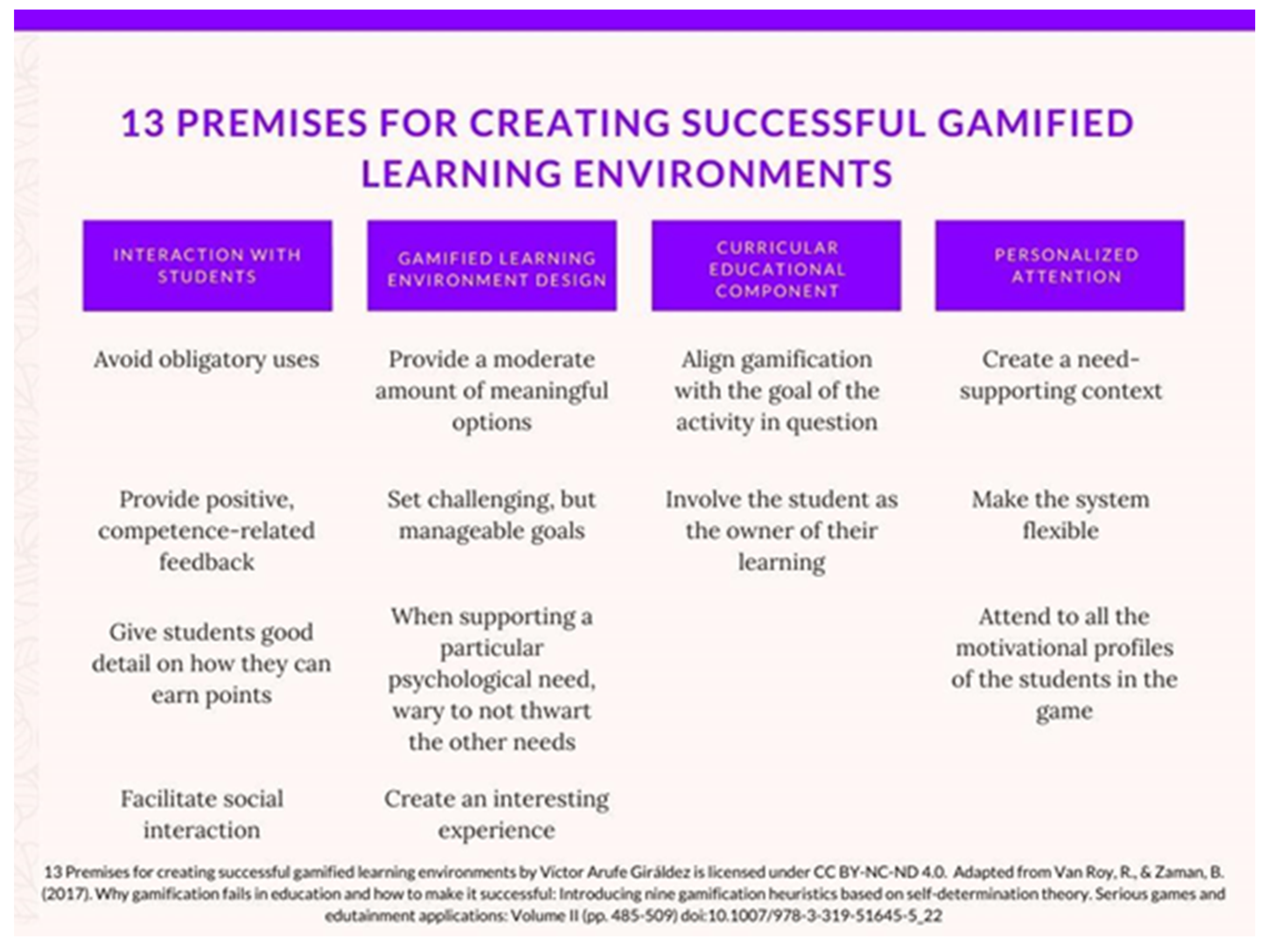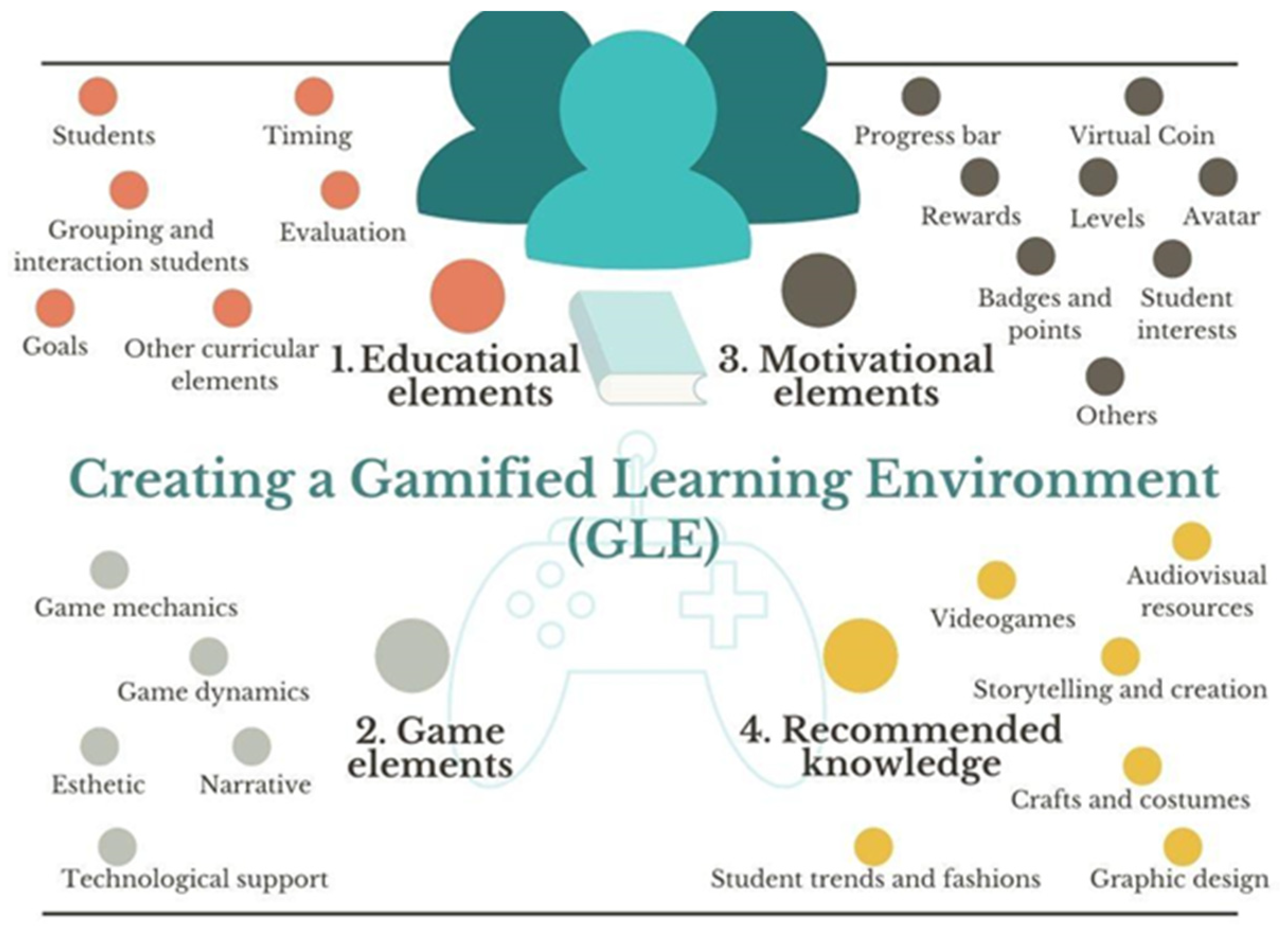You're using an outdated browser. Please upgrade to a modern browser for the best experience.
Please note this is a comparison between Version 2 by Rita Xu and Version 1 by Víctor Arufe-Giráldez.
Gamification along with a whole range of other active methodologies are being incorporated into university classrooms due to their potential benefits for student learning.
- teaching/learning strategies
- gamification
- adult learning
- university
- gamify
- active methodology
1. Gamification as an Active Methodology
One of these methodologies is gamification. Over the last few years there has been an increase in scientific interest in this field [9][1]. Gamification in the educational sphere can be understood as a learning technique which uses elements from games and/or computer games in non-recreational environments, with its main objective being to create behavioural patterns or to encourage certain behaviours in students [10][2]. It can affect the intrinsic and extrinsic motivation of the student and their effort and commitment towards carrying out a certain task [11,12][3][4]. In this sense, its aim is to create attractive and interesting learning experiences that arouse students’ curiosity and capture their continuous attention [13][5]. By means of a systematic review of other empirical studies some authors [14][6] have studied the effects of gamification after its implementation and have confirmed that it can have positive effects, but that these depend on the context in which it is implemented, as well as on the particular users. Another paper [15][7] analysed the impact of a gamified educational experience, showing that it led to an improvement in a few of the studied areas, but a lower performance in others, leading the authors to question some of the common assumptions concerning the benefits of implementing gamification in education. This may be because, as is the case with games and video games, motivation may increase in some people but decrease in others given the ambivalent effect of games, whereby some players may experience feelings of frustration if they do not achieve their purpose [16][8]. Motivation is also influenced by the cognitive and emotional aspects (psychology and neuroscience) of gamification. In this sense, some authors [17][9] uphold the need to establish a cognitive-emotional approach to gamification in order for it to be successful and to engage participants by generating both positive and negative emotions, as there has been little written on how to create emotional experiences through gamification design.
Gamification began in the word of business and quickly caught hold thanks to its level of success in areas such as: improving customer loyalty, worker commitment to their respective companies or the increase in the purchase or contracting of certain products and services [18,19][10][11].
2. The Creation of Gamified Learning Environments (GLEs)
In the sphere of education, it is more correct to speak of the creation of gamified learning environments (GLEs), the design of which is comprised by 4 main blocks and more than 25 key elements [10][2] (see Figure 1).
Other authors, Toda et al. [20][12] have proposed a taxonomy of 21 game elements to be used in GLEs and have organized these elements into 5 categories depending on performance/measurement, environment, social/personal interaction and student experience.
Creating a GLE entails the planning and proper design of the entire process, the steps to be taken, the objectives to be achieved, and the assessment that will measure the attainment of the objectives. Furthermore, it also entails designing all the rules, dynamics, incentive elements and, above all, integrating different areas of knowledge: educational, technological or creative, among others. Van Roy and Zaman [21][13] have pointed out that in order for gamification to be successful in the educational field, nine important premises must be fulfilled, and these have been extended by other authors (see Figure 2).

In ourthe research, gamification focused on the establishment of a system of points, leaderboards and levels that were awarded to students for carrying out different academic activities voluntarily, to reinforce or expand the knowledge acquired during the development of the subject. Other studies [22][14] that addressed the establishment of a point system in students confirm that employing a combination of game elements such as leaderboard, points system, competition, badges, levels, and immediate feedback can serve as a recipe for interactive learning, hence, improves learning outcomes. A literature review on gamification and e-learning education [23][15] confirmed that within the creation of a gamified learning environment the most common gamification elements used and that have a powerful effect on students are points, leaderboards, the badge and the level. Other authors, Amo et al. [24][16] confirmed in a sample of 88,310 users strong causal evidence of points and classification tables established in a gamified informal learning environment, triggering certain structural and trait competitiveness, which interact to affect both engagement and performance growth in contexts informal learning.
Another important aspect to take into consideration in the creation of a GLE is that it must cater to the four player profiles established by Bartle [25][17] in order to guarantee a minimum degree of motivation for each student, regardless of their motivational profile in the game. These are, the killer player who, further than winning, guarantees the existence of losing players, the achiever player, who will seek to win above everything else, earning points, gathering badges, etc., the explorer player who likes facing new challenges and discovering things that others have not been able to and the socializer player, who prioritises the social aspect and interaction with other colleagues and adversaries over other roles. In this sense, Zaric, Lukarov & Schroeder [26][18] highlight the importance to create a balanced, gamified learning environment in which all learners are equally engaged and interested. However, finding the balance between heterogenic learners’ traits and the variety of gamification design elements is a challenging, multistep process. The study confirmed a positive influence of badges, leaderboards, and experience points on learners with reflective, global, visual, and intuitive learning tendencies.
3. The Creation of Gamified and Multimodal Learning Environments in Higher Education
The GLE can be further enhanced if it is set in the context of a multimodal system [27][19], whereby students can continue to work on the contents of the subject in different ways and seek rewards outside the formal educational environment. Thus, multimodal learning systems respond effectively to the demand of many people involved in teaching-learning processes in technologically enriched societies [28][20]. In addition, the use of the internet, social networks and different Information and Communication Technologies (ICTs) can favour content learning outside of the ordinary classroom hours by means of different learning techniques and strategies such as mobile-learning or e-learning [29,30,31,32,33][21][22][23][24][25]. A literature review [34][26] that addressed the perception of university students about gamification in Higher Education confirms a growing interest in the scientific community to propose works on gamification in Higher Education. In addition, a favorable predisposition of students towards the development of innovative didactic experiences based on gamification is corroborated. Among its potential, it stands out the increase in motivation, interest and participation of students in the teaching-learning process, together with the improvement of their academic performance and the development of the skills and competencies necessary for their professional development.References
- Chacón, J.P.; Suelves, D.M.; Isabel Vidal Esteve, M.A. Bibliometrics applied to gamification as a digital learning strategy. Rev. Educ. A Distancia 2019, 60, 19.
- Arufe Giráldez, V.; Navarro-Patón, R. Creación de un entorno de aprendizaje gamificado inspirado en la casa de papel. In Metodologías Activas en la Práctica de la Educación Física; Morente Oria, H., González Fernández, F.T., Sánchez Fernández, A.S., Eds.; Ediciones Morata: Madrid, Spain, 2020; pp. 65–83.
- Prieto Andreu, J.M. A systematic review about gamification, motivation and learning in high school. Teoría Educ. 2020, 32, 73–99.
- Treiblmaier, H.; Putz, L. Gamification as a moderator for the impact of intrinsic motivation: Findings from a multigroup field experiment. Learn. Motiv. 2020, 71, 101655.
- Hong, J.; Hwang, M.; Liu, Y.; Tai, K. Effects of gamifying questions on english grammar learning mediated by epistemic curiosity and language anxiety. Comput. Assist. Lang. Learn. 2021, 1–25.
- Hamari, J.; Koivisto, J.; Sarsa, H. Does gamification work?—A literature review of empirical studies on gamification. In Proceedings of the 47th Hawaii International Conference on System Sciences (Hicss), Waikoloa, HI, USA, 6–9 January 2014; pp. 3025–3034.
- Domínguez, A.; Saenz-de-Navarrete, J.; de-Marcos, L.; Fernández-Sanz, L.; Pages, C.; Martínez-Herráiz, J. Gamifying learning experiences: Practical implications and outcomes. Comput. Educ. 2013, 63, 380–392.
- Van Roy, R.; Zaman, B. Unravelling the ambivalent motivational power of gamification: A basic psychological needs perspective. Int. J. Hum. Comput. Stud. 2019, 127, 38–50.
- Mullins, J.K.; Sabherwal, R. Gamification: A cognitive-emotional view. J. Bus. Res. 2020, 106, 304–314.
- Blohm, I.; Leimeister, J.M. Gamification design of IT-based enhancing services for motivational support and behavioral change. Bus. Inf. Syst. Eng. 2013, 5, 275–278.
- Gatautis, R.; Vitkauskaite, E.; Gadeikiene, A.; Piligrimiene, Z. Gamification as a mean of driving online consumer behaviour: SOR model perspective. Inz. Ekon. Eng. Econ. 2016, 27, 90–97.
- Toda, A.M.; Palomino, P.T.; Oliveira, W.; Rodrigues, L.; Klock, A.C.T.; Gasparini, I.; Isotani, S. How to gamify learning systems? An experience report using the design sprint method and a taxonomy for gamification elements in education. Educ. Technol. Soc. 2019, 22, 47–60.
- Van Roy, R.; Zaman, B. Why gamification fails in education and how to make it successful: Introducing nine gamification heuristics based on self-determination theory. In Serious Games and Edutainment Applications; Springer: Berlin/Heidelberg, Germany, 2017; Volume II, pp. 485–509.
- Haruna, H.; Zainuddin, Z.; Okoye, K.; Mellecker, R.R.; Hu, X.; Chu, S.K.W.; Hosseini, S. Improving instruction and sexual health literacy with serious games and gamification interventions: An outlook to students’ learning outcomes and gender differences. Interact. Learn. Environ. 2021, 1–19.
- Saleem, A.N.; Noori, N.M.; Ozdamli, F. Gamification applications in E-learning: A literature review. Technol. Knowl. Learn. 2021, 27, 139–159.
- Amo, L.; Liao, R.; Kishore, R.; Rao, H.R. Effects of structural and trait competitiveness stimulated by points and leaderboards on user engagement and performance growth: A natural experiment with gamification in an informal learning environment. Eur. J. Inf. Syst. 2020, 29, 704–730.
- Bartle, R.A. MMOs from the Inside Out: The History, Design, Fun, and Art of Massively-Multiplayer Online Role-Playing Games; Apress: New York, NY, USA, 2015; pp. 1–735.
- Zaric, N.; Lukarov, V.; Schroeder, U. A fundamental study for gamification design: Exploring learning tendencies’ effects. Int. J. Serious Games 2020, 7, 3–25.
- Doumanis, I.; Economou, D.; Sim, G.R.; Porter, S. The impact of multimodal collaborative virtual environments on learning: A gamified online debate. Comput. Educ. 2019, 130, 121–138.
- Cotta Orlandi, T.R.; Gottschalg Duque, C.; Mori Mori, A.; de Andrade Lima Orlandi, M.T. Gamificação: Uma nova abordagem multimodal para a educação. Biblios 2018, 70, 17–30.
- Aguilera Maldonado, J.G. Carácter Multimodal y Multidisciplinar e Las Redes Sociales. Uso de Las Nuevas Tecnologías y Dinámicas de Grupo en el Aula de Inglés Para Ciencias de la Salud en la Universidad: Efectos Sobre la Incorporación al Mercado Laboral en la Comunidad Valenciana. Ph.D. Thesis, Universitat Jaume, Castellón de la Plana, Spain, 2014.
- Canazza, S.; Foresti, G.L. A multimodal learning system for individuals with sensorial, neuropsychological, and relational impairments. J. Sens. 2013, 2013, 564864.
- Hernández-Ramos, P. How does educational technology benefit humanity? Five years of evidence. J. Educ. Technol. Soc. 2006, 9, 205–214.
- Jeng, Y.; Wu, T.; Huang, Y.; Tan, Q.; Yang, S.J.H. The add-on impact of mobile applications in learning strategies: A review study. Educ. Technol. Soc. 2010, 13, 3–11.
- Moreno, R.; Mayer, R. Interactive multimodal learning environments: Special issue on interactive learning environments: Contemporary issues and trends. Educ. Psychol. Rev. 2007, 19, 309–326.
- Palomino, P.; del Carmen, M. Implications of gamification in Higher Education: A systematic review of student perception. RIE—Rev. Investig. Educ. 2021, 39, 169–188.
More

